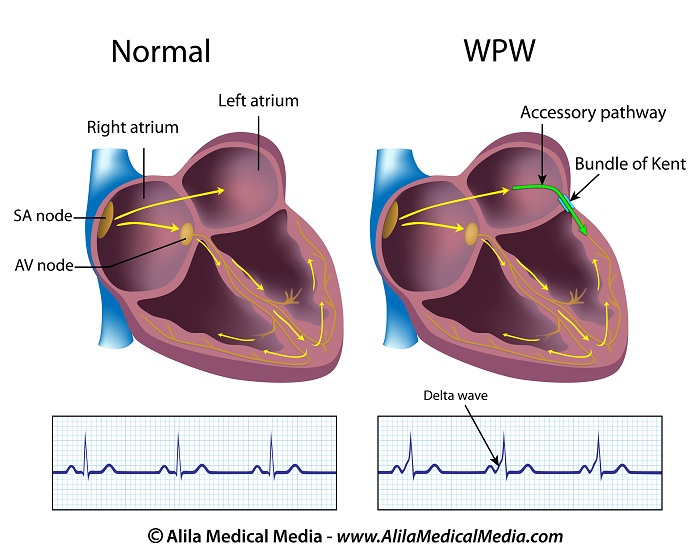Wolff-Parkinson-White Syndrome Explained Clearly
WPW Syndrome Pathophysiology and ECG explained in 4 min - It's mind-boggling how easy it is!
This lesson includes an animated video lecture, downloadable images, quiz questions and a PDF
Wolff-Parkinson-White, or WPW, syndrome is a congenital heart disease characterized by presence of an abnormal electrical connection between the atria and ventricles of the heart. WPW typical symptom is an abnormally fast heart rate, or tachycardia.
In normal conduction, electrical signals are initiated in the SA node, and travel throughout the atria before they reach the AV node. The AV node is the gateway to the ventricles. It delays the passage of electrical impulses to the ventricles to ensure that the atria have ejected all the blood into the ventricles before the ventricles contract. This refractory property of the AV node is essential in limiting electrical activities that reach the ventricles. In situations where the atrial rate is excessively high, such as during atrial fibrillation or atrial flutter, the AV node blocks most of the impulses from passing to the ventricles, keeping the heart rate under control.
In WPW, there is an additional connection between the atria and the ventricles, called the accessory pathway, or bundle of Kent.
This pathway is essentially a patch of conductive tissue that provides a shortcut to the ventricles, bypassing the AV node. It allows part of electrical impulses to arrive to the ventricles sooner, causing a so-called “pre-excitation”.
This can be seen as a shortened PR interval on an ECG. Because part of the ventricles depolarize earlier, ventricular depolarization develops in a more gradual fashion and lasts longer, resulting in a slurring slow rise of the initial portion of the QRS complex, known as Delta wave, and QRS prolongation. 
To note, however, that the presence of an accessory pathway alone does not cause tachycardia...
Subscribe to one of the courses below to continue!
This content is available within the following courses:

Our Signature Animated Videos on Electrocardiography: 25 animations, plus downloadable PDFs, downloadable images, and quizzes.

Our Signature Animated Videos on Electrocardiography: 25 animations, plus downloadable PDFs, downloadable images, and quizzes.